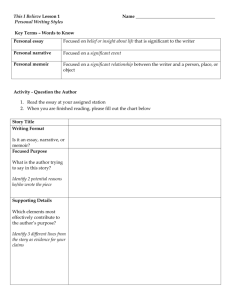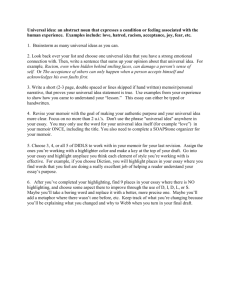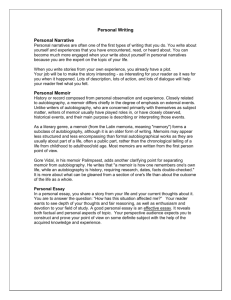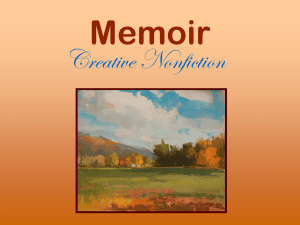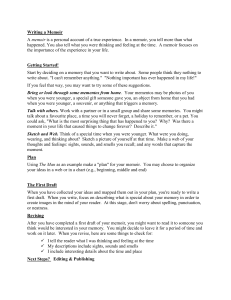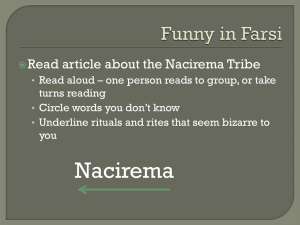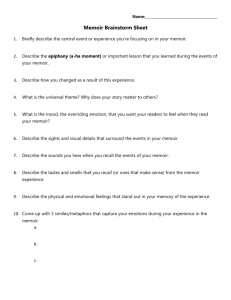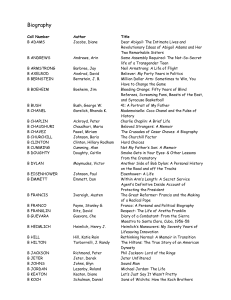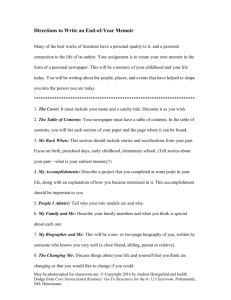Narrative Craft: Help Students Write Structured
advertisement
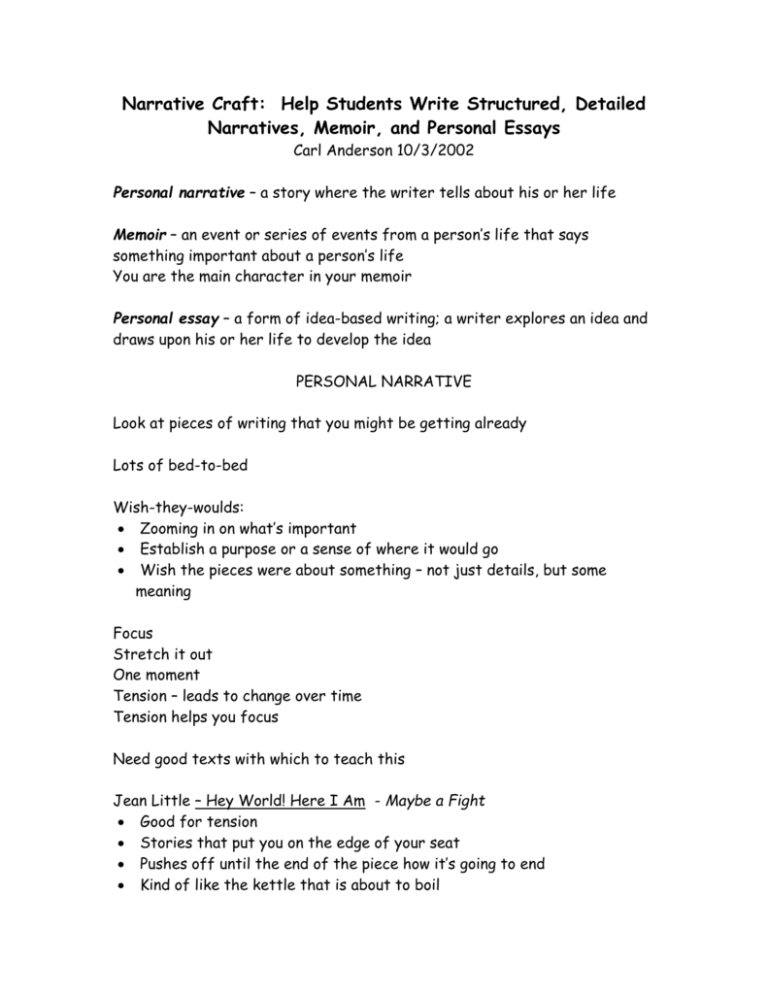
Narrative Craft: Help Students Write Structured, Detailed Narratives, Memoir, and Personal Essays Carl Anderson 10/3/2002 Personal narrative – a story where the writer tells about his or her life Memoir – an event or series of events from a person’s life that says something important about a person’s life You are the main character in your memoir Personal essay – a form of idea-based writing; a writer explores an idea and draws upon his or her life to develop the idea PERSONAL NARRATIVE Look at pieces of writing that you might be getting already Lots of bed-to-bed Wish-they-woulds: Zooming in on what’s important Establish a purpose or a sense of where it would go Wish the pieces were about something – not just details, but some meaning Focus Stretch it out One moment Tension – leads to change over time Tension helps you focus Need good texts with which to teach this Jean Little – Hey World! Here I Am - Maybe a Fight Good for tension Stories that put you on the edge of your seat Pushes off until the end of the piece how it’s going to end Kind of like the kettle that is about to boil Setting detail (kettle) that mirrors the rest of the story Start study by reading a couple of stories to get a feel for this kind of writing Give time to story-telling in class “Typical” way to tell a story (bed to bed, boring recounting of details, no picking and choosing the important ones, tension – if any is resolved right at beginning) Then tell the same account like it is a story – with tension, attention to the right details, keeping them on the edge of their seat, smaller focus Which way do you think I’m doing it better? Model it for kids– Anzia in park with dad Let them do some storytelling Challenge them to do it well Teacher confers with groups Then a kid might tell a story to the whole class – with the teacher coaching – say more about that part, stretch it out there Notebook work Reread notebook for entries that contain a story Show the kids an entry from your notebook that feels like it has a story in it I read the entry and I found a story in it Then show the kids the way you planned it out (notebook) Your thinking about a possible lead (notebook) Draft of the story you wrote (out of notebook) Put kids’ entries up and look for the story in them together Younger grades – they will write a couple personal narratives during the study What’s the part of the entry that puts the reader on the edge of his seat? For kids who are developing a seed idea – Read through entries and find one that feels most story-like Try out important scenes in a writer’s notebook before drafting Practicing craft of key parts Mini-lessons Story “arc” Change over time Problem/solution Writer establishes tension at beginning and doesn’t give the show away Make a plan for the narrative What are the parts of the story? Make a plan Circle hot spots Writing a lead that creates tension Establishes the focus and tension of the piece Sometimes the lead is the whole first scene Sometimes the first paragraph is full of setting detail and then when the “one day” comes in the next paragraph, the tension is created Don’t let us know until the end how it’s going to work out [story idea – Susan calls from college, lost in SC] When you ask them to add more detail – they just add more content – more of the same We must help them to know what kinds of detail they are: Dialogue Thinking Character gesture/movement Setting detail Physical description of character Weave in and out using different kinds of details Barry Lane, After the End Snap shots Thought shots Exploding moments Shrinking centuries Hot spots – can either: Establish tension Build tension Resolve tension Can help kids by finding, identifying, planning for hot spots before they draft MEMOIR Details – narrative details – still apply in memoir study Find out about his life – tells you what it means about his life – at beginning of piece, woven through the piece, and at the end Look at experience in your life and extract a meaning from it – sophisticated cognitive move There should be a place in the text where you can point to the part that states the meaning that the memoir has for the writer (when you are teaching it – not true of all memoir) Doesn’t always exist in memoir but is good to use in a touchstone text Chapter 6 from Little by Little, Jean Little Look at structure of one page Memory – meaning Memory – memory – memory - meaning (whole chapter) Use whole chapter for more sophisticated writers Eleven could be used to teach memoir or personal essay – really is fiction Memoir study Start with immersion What do you notice? Message oriented Seems a little like fable writing: story – moral Strategies for remembering memories Process of writing to learn; meaning-making exercise Think back to memories Write off objects Photos that mean something Inside Out, Tom Kirby Making a life map (let kids choose if they want to try it) Then look at map and write off of it Seeking Diversity, Linda Reif Positive and negative life graph In personal narrative, the tension is the controlling idea Memory box, heart map Choose amongst those kinds of strategies Key to the work comes in after they pick what they’re writing about How do they come up with an idea about what they have to say? What’s the point of the memoir? Look over entries about topic to find meaning Meaning helps you choose parts to include Remember that memoir is about you, so even if another person is part of your topic, it’s what it means to you that must be discovered What’s the big idea – line of thinking Figuring out the life lesson What are you trying to say to readers? Some writers figure out right away what it is about Others take a while – must write to discover it Conference question: So what’s the thing you want to tell readers about? Try to bring out idea by nudging them towards it Sometimes the meaning is just as simple as “I love my mom.” We don’t need to push them to too sophisticated meanings Amy Tan, NY Times spring 2002 memoir about her mom Read your entries over and ask yourself, “What does this say to me?” Focusing line – leading you to the controlling idea Before drafting – Structures that memoirists use Box out parts of touchstone texts Little by Little – scenes – put in appropriately sized boxes Morning Afternoon Morning Afternoon meaning Memory – meaning – memory – memory – meaning Memory – meaning Meaning – memory – meaning Get kids to box out a text after you model one for them Big idea Example Techniques for developing scenes Narrative detail (same as in personal narrative) Pick the parts that add up to the meaning – in memoir Pick the parts that build up and resolve your tension – in personal narrative Some memoir is not story – no tension – just an anecdote, a scene Some memoirs are stories – help them do the story part better if they are Looking at kids’ work Notice where the meaning-making is and be sure that the rest of the draft supports that – add those in – take out other places that don’t support meaning PERSONAL ESSAY Idea-based writing The writer takes you on a journey of thinking about an idea Personal anecdote supports the thinking What a Writer Needs – pg. 157 essay on parents by 8th grader in NY Look in newspapers Newsday Column on Monday authored by teenagers Weekend in part two Write-in column on Monday – often essays A dance between ideas and personal experience See-saw structure in American Thin Life for everyone as teenager – life for me Lunch for everyone – lunch for me Journey along some line of thinking Sometimes at the end you come to a conclusion, but it is not necessarily stated strongly at the beginning and supported all the way through More explication of idea woven through the text Studying Personal Essay Read essays – immerse Rereading notebooks for ideas for essays – focusing lines Find ideas that already exist They might want to stay with these to explore and develop them Question – exploring it – entry could feel like an essay already You could find a line and push off from that Focusing line –line that develops an idea from which you can push off` Wondrous Words – looking at touchstone text and wondering about the work the writer did in advance Decisions in life are sometimes difficult Listing things about the idea Gathering anecdotes for personal essay Go from specifics to general Drafting Looking at the structure of touchstone texts – box them out 3-paragraph anecdote Idea Story Idea Story Idea Tiny anecdote General/specific General/specific There are specific and predictable moves you make in dancing as well as in writing an essay Need to think of narrative details in the anecdote sections: Dialogue Internal story Character detail Setting detail Character movement This is done in a more painterly way than in a narrative – the painter suggests the form with just paint Economy of detail – moving back and forth from ideas to anecdotes – sometimes with a new paragraph
